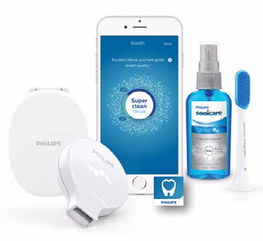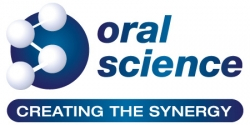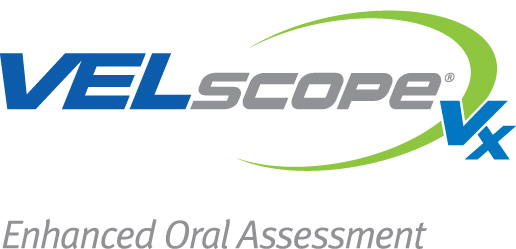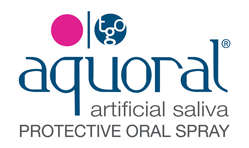May 2017 • Jo-Anne Jones, RDH • Oral Health Magazine • Oral Hygiene
How Is My Breath? The immense concern of the general population towards halitosis or oral malodor is very real. This is reflected in the North American multi-billion dollar cosmetic fresh breath product portfolio aimed to help the consumer treat the condition. “Up to 50% of the U.S. {general} population reports that their own ‘bad breath’ has concerned them during some point in the course of their lifetime. Half of this group is indeed likely to have an ongoing sporadic or a chronic breath malodor problem.”1, 2 The public often make numerous daily, yet ineffective attempts to cover up this social problem with excessive brushing, mouth rinsing, use of mints and flavored chewing gum.
The social stigma that oral malodor presents is a key opportunity for the dental hygienist to engage in dialogue with the dental hygiene client beginning with communication pertaining to possible etiologic pathways. The etiologic factors are quite diverse and represent a wide gamut spanning from poor or ineffective daily oral self-care measures to systemic disease. Both intrinsic and extrinsic pathways have been identified that contribute to oral malodor. These include the oral cavity, oropharynx, nasopharyngeal areas, respiratory tract, gastrointestinal diseases and disorders, xerostomia and odor causing foods, fluids and medications. “Historically education has focused on systemicbased malodor conditions. However, 80% to 90% of malodor originates from oral cavity.”3 “The source of 90% of cases is the oral cavity such as poor oral hygiene, periodontal disease, tongue coat, food impaction, unclean dentures, faulty restorations, oral carcinomas, and throat infections.”4 The tongue is a prominent anatomical site accounting for the majority of oral malodor.
Determining the etiologic factors will help direct the management pathway. For example, the dental hygienist has a prime opportunity to inform a client of the relationship with oral malodor if the client is taking one or more of the over 400 prescription drugs that induce xerostomia. Counselling and product recommendation to combat the effects of xerostomia and the potential environment for subsequent malodor would be indicated. This dialogue can occur during the medical history and may provide a more natural segue into a meaningful conversation rather than trying to initiate the conversation on its own.
The principle components of oral malodor are volatile sulfide compounds (VSC) being mainly hydrogen sulfide, methyl mercaptan and dimethyl sulfide. Both hydrogen sulfide and methyl mercaptan account for about 90% of the volatile sulfur compounds found in oral malodor. These compounds result from the proteolytic degradation by predominantly anaerobic Gram-negative oral microorganisms of various sulfur-containing substrates in food debris, saliva, blood, and epithelial cells.5 Research validates the cause of the oral malodor is directly related to the metabolic activities and breakdown of gramnegative anaerobic bacteria. Microorganisms specifically identified with both gingivitis and periodontitis are connected with the production of large amounts of VSC. “The presence of B. forsythus, P. gingivalis and P. intermedia influenced the production of VSC. Specifically, the presence of B. forsythus in subjects with periodontitis was strongly correlated to the concentration of VSC in mouth air.”6 Research has also brought to light the role oral malodor plays in the progression of periodontal infections;7 the point being that both oral malodor and periodontal disease are interconnected.
HISTORICAL ANALYSIS OF ORAL MALODOR
One of the most reliable methods of detecting oral malodor is our ‘sense of smell’. Using this method for evaluative purposes presents its obvious discomfort for both the clinician and the client. The ability to develop a device with the accuracy and sensitivity of the human nose has been a challenge to the research community.8
The Halimeter® is an internationally recognized instrument for measuring oral malodor (Figure 1). The Halimeter was traditionally used as a measuring device in dental research studies to assess VSC levels however is now used by over 3,000 dentists in private practice.9 Noteworthy contributions include leaders in our dental hygiene community such as Anne Bosy, RDH, BSc, MS, Med, recognized internationally as a scientist, researcher and inventor who dedicated 15 years of practice to the Fresh Breath Clinic which operated in Toronto, Canada.
Continual product innovations are emerging on the consumer markets; however, are they simply masking the problem and not encouraging healthy oral hygiene habits that are going to effectively address the issue? The multi-faceted complex nature of halitosis coupled with the hesitancy for the dental hygienist to approach the subject has resulted in a distinct lack of integration of fresh breath protocols both chairside and for self-care.
MEASURE, LEARN AND IMPROVE
Philips Oral Healthcare, a prominent leader in innovative oral health solutions, diligently went to work on addressing this global issue of public concern over breath quality. The impetus behind this was fueled by the knowledge that the type of bacteria responsible for oral malodor is also associated with other oral health problems. It is a global concern that goes far beyond the social stigma of ‘bad breath’.
 “How is my breath?” Now we have an opportunity to provide an accurate response to this question. Philips has recently launched the Philips Sonicare Breath Care system being the first digitally connected complete breath management system utilizing Breathometer™ sensor technology. The ‘smart’ Bluetooth ® technology integrates with the free Philips Sonicare app to analyze breath in 30 seconds with professional accuracy displaying real time breath measurements of VSC syncing data to track breath quality and oral care habits over time. How does it work? The sensor inside the breath analyzer employs professional detection technology to detect hydrogen sulfide, methyl mercaptan, and dimethyl sulfide VSCs and reports results in parts per billion (0-500PPB). It is calibrated to replicate professional breath quality measurement devices used in laboratories and dental offices. Data tracking then has the ability to provide tailored tips and personalized insights to educate our clients as to how to manage their overall oral care routines to maximize outcomes.
“How is my breath?” Now we have an opportunity to provide an accurate response to this question. Philips has recently launched the Philips Sonicare Breath Care system being the first digitally connected complete breath management system utilizing Breathometer™ sensor technology. The ‘smart’ Bluetooth ® technology integrates with the free Philips Sonicare app to analyze breath in 30 seconds with professional accuracy displaying real time breath measurements of VSC syncing data to track breath quality and oral care habits over time. How does it work? The sensor inside the breath analyzer employs professional detection technology to detect hydrogen sulfide, methyl mercaptan, and dimethyl sulfide VSCs and reports results in parts per billion (0-500PPB). It is calibrated to replicate professional breath quality measurement devices used in laboratories and dental offices. Data tracking then has the ability to provide tailored tips and personalized insights to educate our clients as to how to manage their overall oral care routines to maximize outcomes.
The Philips Sonicare Breath care system includes the Philips Sonicare Breath analyzer which works with the Philips Sonicare app experience with coaching and education designed by dental professionals, and the Philips Sonicare TongueCare+ tongue brush head and spray (Figure 2). The TongueCare+ tongue brush head is a soft silicone brush containing 240 microbristles optimally designed to remove bacterial biofilm from the tongue’s complex surface. The brush head conveniently transforms the Sonicare toothbrush handle into a sonic-powered tongue cleaner employing the Sonicare technology of 31,000 strokes per minute. The Breath Rx tongue spray is an alcohol free spray containing 0.09% CPC (cetylpyridinium chloride) and, Zytex. Zytex is a proprietary formula of antibacterial eucalyptus, thymol oils and odor-neutralizing zinc gluconate. The combined use of both the mechanical properties of the tongue care brush head and the chemical action of Breath Rx tongue spray effectively removes debris and kills 99% of oral malodor bacteria* resulting in the neutralizing of VSC gases.
A clinical study was conducted to investigate the effectiveness of TongueCare+ (TC) coupled with a sonic powered toothbrush handle in combination with an antibacterial tongue spray (BreathRx) containing 0.09% cetylpyridinium chloride and 0.7% zinc gluconate. 10 Inclusion criteria for study participants in this cross-over clinical investigation were the identification of oral malodor exceeding normal thresholds. The study methods consisted of four treatment arms with a one week period in between. Malodor levels and bacterial density were monitored up to 6 hours. The results of this clinical investigation demonstrated that the combined use of a the sonic-powered tongue cleaning brush head used in conjunction with the antibacterial tongue spray resulted in the ability to deliver six hours of fresh breath following a single-use (Figure 3).
In conclusion, we literally have an opportunity now to revolutionize behavioral modification (Figure 4). If we are able to tangibly illustrate how oral care habits influence one of the leading social concerns being oral malodor, we have now opened the door to internal motivation and change behavior. How is my breath? Empower your dental hygiene client to measure, learn and improve being confident in the management of oral malodor and the attainment of fresh breath.
You can read the full article now or save it to read late by clicking and saving the PDF below.
Acknowledgements: Article used with permission and thanks to ORAL HYGIENE Magzine. See more at Oral Health Group











